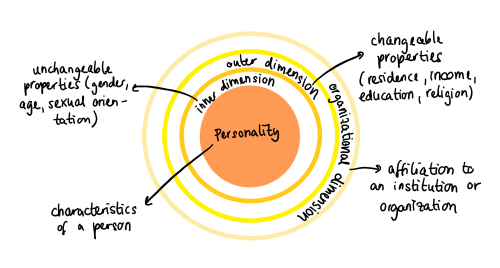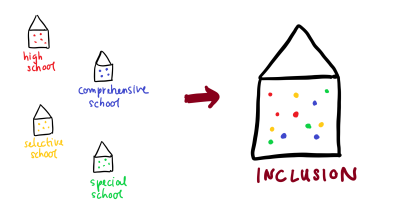Christian Stoll & Ceylan Türkyilmaz 2023
Internal Differentiation
Internal differentiation
People are not the same. Every person is different. People differ by their appearance, their size, their hair colour, their interests, their origin and so on. This is referred to as diversity.
 Abb. 1: Four Layers of Diversity
Abb. 1: Four Layers of Diversity
The model “Four Layers of Diversity” by Gardenswartz and Rowe ( Abbildung 1) (Gardenswartz; Rowe, 2021) depicts diversity of people on four levels. In the centre, you will find the “personality” layer. It’s encircled by the “inner dimension” layer, which includes relatively unchangeable properties (e.g. gender, age, sexual orientation. These are also mentioned in the principles of equality. The “outer dimension” focuses on the changeable properties such as residence, income, education or religion. Lastly, the outermost circle refers to a person's affiliation with an institution or organization. For example, affiliation with a university (Universität Wien, 2021).
This “Four Layers of Diversity” model illustrates how multi-layered a person can be and clarifies which external circumstances can have an impact on a person's traits and identity. There are, of course, many more aspects in which people differ, for example, in acquiring or practicing new knowledge. That means the preferred way of learning can vary greatly from person to person. Among other things, this also depends on the skills, abilities, and prior knowledge a person has when entering a school or university. As teachers, we must assume that learning groups, regardless of the type of school or course of education we are in, are very different, i.e., heterogeneous.
To do justice to the heterogeneity of learning groups, there are various methods that promote differentiated learning. A basic distinction can be made between two forms of differentiation. The external differentiation refers to the permanent division of learning groups according to certain criteria, which achieves the greatest possible homogeneity within these groups. This kind of division can be based on specific educational goals (e.g., specializations or career paths), age or level of skills and abilities (e.g., belt colours in martial arts). Another form of external differentiation is the allocation to the following schools: high school, comprehensive school, selective school, and special school. However, it is precisely this differentiation that has turned out to be unfavourable for a variety of reasons. Therefore, teaching-learning processes currently follow the principles of internal differentiation. Internally differentiated teaching enables an individualized learning process, which is adapted to the personality of the learner (QUA-LiS NRW, 2022).
Depending on the knowledge and abilities of the learners, there are differently demanding tasks, materials, or media. During group work, the composition of the group members should be balanced so that the students can support each other in case of arising problems. Another important aspect is giving students choices, i.e. letting them decide for themselves which topics/content they would like to cover or which methods they prefer to use (Birri, T., 2013).
The main goal of all these methods is to create open lessons in which students can actively work on their own development. In short, key aspects of cooperative learning are group works and self-directed learning, i.e. students learn how to acquire new content and skills most effectively on their own (Budde, J., 2018).
To conclude, one can say that internally differentiated teaching is the basis for inclusive schooling. Inclusion also puts special emphasis on students with disabilities or other specific needs. The basic idea of inclusive schooling (Schöb 2013) is to create an opportunity to learn and develop within the regular school system (internal differentiation) and not in separated school forms (external differentiation) (Schöb, A., 2013).
